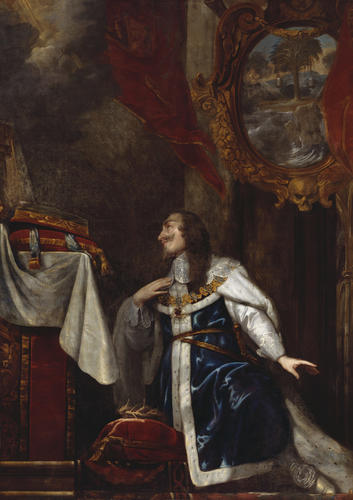-
1 of 253523 objects
A Memorial Picture of Charles I (1600-49) 1660s
Oil on canvas | 252.7 x 178.7 cm (support, canvas/panel/stretcher external) | RCIN 405715

British School, 17th century
A Memorial Picture of Charles I (1600-49) 1660s
-
Ten days after his execution of 30 January 1649 Charles I’s spiritual autobiography was published – the ‘Eikon Basilike’ or ‘Image of the King’. It is not certain whether this work was written by the King himself or ‘ghosted’ by John Gauden, Bishop of Worcester, but it was an extremely popular piece of Royalist justification and a central part of the development of the cult of King Charles the Martyr (who remains the only Saint canonised by the Church of England). Milton’s riposte, the ‘Eikonoklastes’ (‘The Iconoclast’ or ‘Image-Breaker’) of 1649, did not prevent this work of popular piety from going into many editions. The frontispiece of the ‘Eikon’, designed by William Marshall, and filled with allegorical devices, has always been as famous as the book itself. While not actually copying its composition at all, this painting is entirely derived from Marshall’s print. The King is shown dressed in full earthly splendour - coronation robes, Garter chain, lace collar and so on – but kneeling and praying fervently to an altar upon which is placed a Bible and above which the heavens open. The King has placed a crown of thorns on a cushion at his feet as if offering it (or perhaps taking it up). All the same things happen in the ‘Eikon’ frontispiece except that the King here explicitly takes a crown of thorns labeled ‘Grace’ in exchange for an earthly crown, labeled ‘Vanity’. Many of the allegories which in the ‘Eikon’ fill a landscape outside the chapel in which the King kneels have, in this case, been crowded into a painting-within-a-painting in a fine Baroque frame including a skull. A rock resists some waves and some winds (puffing faces); the same thing is the ‘Eikon’ is labeled ‘Immota, Triumphans’ (‘Unmoved Triumphant’). A palm tree is hung with weights because this tree was said to grow straighter the more weight it bears; in the ‘Eikon’ the same image bears the rubric ‘Crescit sub pondere Virtus’ (‘Virtue grows under weights’, that is in adversity). Such a splendid and public image must have been commissioned after the Restoration, and probably quite soon after, while the matter was still current in people’s minds. A date from the 1660s would certainly fit with the painting’s style.
Provenance
Purchased by Sir J.C. Robinson at Foster's, 22 July 1891 (89); purchased for the Royal Collection by Queen Victoria in 1892 (PRO LC1/552, II, 79; 570, 93)
-
Creator(s)
Acquirer(s)
-
Medium and techniques
Oil on canvas
Measurements
252.7 x 178.7 cm (support, canvas/panel/stretcher external)
282.5 x 201.5 x 9.5 cm (frame, external)
Category
Object type(s)
Other number(s)
Alternative title(s)
Charles I